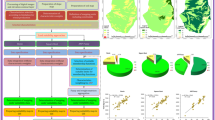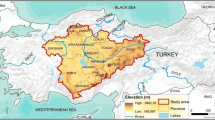Abstract
Modeling agriculture land suitability at a regional scale plays an important role in designing the best sustainable management systems. The aim of this study was to derive a land suitability map for wheat farming by combining the Geostatistics and analytic hierarchy (AHP)-Fuzzy algorithm in geographic information system (GIS) in calcareous and saline–sodic soils, southern Iran. The local expert’s opinions were used to make a decision on the weighting of climate, terrain, and soil data by applying an AHP method. The input data were transformed to a fuzzy-set data. The Spherical and Gaussian semi-variogram models had the best performance for fitting the soil parameters. The results revealed that soil texture (w = 0.207), pH (w = 0.121), slope (w = 0.120), electrical conductivity (w = 0.113), and exchangeable sodium percentage (w = 0.111) had the highest specific weighting for wheat production, respectively. The land suitability map indicated that 25.65% (48306.6 ha) of the studied area was for highly suitable, 38.2% (71939.7 ha) was moderately suitable, and 27.63% (52017.2 ha) was marginally suitable. Only 8.52% (16042.4 ha) of the studied area was not suitable for wheat farming. In conclusion, a combination of AHP, Fuzzy, and GIS could be a potential approach for site-specific soil management, land-use planning, and protection of the environment.





Similar content being viewed by others
References
Akinci H, Ozalp AY, Turgut B (2013) Agriculture land use suitability analysis using GIS and AHP technique. Comput Electron Agric 97:71–82
Banai R (2005) Land resource sustainability for urban development: spatial decision support system prototype. Environ Manag 36(2):282–296
Banai R (1993) Fuzziness in geographical information systems: contributions from the analytic hierarchy process. Int J Geographical Inf Syst 7(4):315–329
Baroudy AAE (2016) Mapping and evaluating land suitability using a GIS-based model. Catena 140:96–104
Bandyopadhyay S, Jaiswal RK, Hegde VS (2009) Assessment of land suitability potentials for agriculture using a remote sensing and GIS based approach. Int J Remote Sens 30(4):879–895
Boyer JS, James RA, Munns R (2008) Osmotic adjustment leads to anomalously low estimates of relative water content in wheat and barley. Funct Plant Biol 35(11):1172–1182
Brady NC, Weil RR (2002) The nature and properties of soils, 13th edn. Prentice Hall, New Jersey
Cressie N (1993) Statistics for spatial data. John Wiley and Sons, New York, NY
Eldeiry AA, Garcia LA (2010) Comparison of regression kriging and cokriging techniques to estimate soil salinity using Landsat images. J Irrig Drain Eng 136:355–364
FAO (1976) A Framework for Land Evaluation. Food and Agriculture Organization of the United Nations, Soils Bulletin No.32. FAO, Rome
FAO (1990) Guidelines for Soil Profile Description, 3rd ed. Food and Agriculture Organization of the United Nations, Rome, Italy
FAO (2005) Fertilizer use by Crop in Iran. Food and Agriculture Organization of the united nations, Rome
Falasca SL, Ulberich AC, Ulberich E (2012) Developing an agro-climatic zoning model to determine potential production areas for castor bean (Ricinus communis L.). Ind Crops Prod 40:185–191
Fontes MPF, Fontes RMO, Carneiro PAS (2009) Land suitability, water balance and agricultural technology as a geographic-technological index to support regional planning and economic studies. Land Use Policy 26:589–598
Foth HD (1990) Fundamentals of soil science. Wiley, New York, NY
Fu Z, Li Z, Zai C (2011) Soil thickness effect on hydrological and erosion characteristics under sloping lands: a hydropedological perspective. Geoderma 167–168:41–53
Gee GW, Bauder JW (1986) Particle size analysis. In: Klute A (Ed.) Methods of Soil Analysis: Part 1 Agronomy Handbook No 9. American Society of Agronomy and Soil Science Society of America, Madison, WI, pp 383–411
Girvan MS, Bullimore J, Pretty JN (2003) Soil type is the primary determinant of the composition of the total and active bacterial communities in arable soils. Appl Environ Microbiol 69:1800–1809
Grassano N, Tedone L, Verdini L (2011) Evaluation of rapeseed cultivation suitability in Apulia with GIS-multicriteria analysis. Italian. J Agron 6(2):e16
Hoseini Y (2019) Use fuzzy interface systems to optimize land suitability evaluation for surface and trickle irrigation. Info Process. Info Process Agri 6:11–19
Karimi F, Sultana S, Shirzadi Babakan A (2018) Land suitability evaluation for organic agriculture of wheat using GIS and multicriteria analysis. Pap Appl Geog 4(3):326–342
Kazemi H, Sadeghi S, Akinci H (2016) Developing a land evaluation model for faba bean cultivation using geographic information system and multi-criteria analysis (A case study: Gonbad-Kavous region, Iran). Ecol Ind 63:37–47
Keshavarzi A (2010) Land suitability evaluation using fuzzy continuous classification (a case study: Ziaran region). Mod Appl Sci 4:10
Lai V, Wong BK, Cheung W (2002) Group decision making in a multiple criteria environment; a case using the AHP in the software selection. Eur J Oper Res 137(1):134–144
Li Y (2010) Can the spatial prediction of soil organic matter contents at various sampling scales be improved by using regression kriging with auxiliary information? Geoderma 159:63–75
Malczewski J (1999) GIS and multicriteria decision analysis. John Wiley and Sons, New York, NY
Mandal VP, Rehman S, Ahmed R, Masroor M, Kumar P, Sajjad H (2020) Land suitability assessment for optimal cropping sequences in Katihar district of Bihar, India using GIS and AHP. Spat. Inf. Res. https://doi.org/10.1007/s41324-020-00315-z
Matheron G (1963) Principles of geostatistics. Econ Geol 58:1246–1266
Mendas A, Delali A (2012) Integration of multi-criteria decision analysis in GIS to develop land suitability for agriculture: application to durum wheat cultivation in the region of Mleta in Algeria. Comput Electron Agric 83:117–126
Mirzaee S, Ghorbani-Dashtaki S, Mohammadi J, Asadi H, Asadzadeh F (2016) Spatial variability of soil organic matter using remote sensing data. Catena 145:118–127
Mirzaee S, Ghorbani-Dashtaki S, Kerry R (2020) Comparison of a spatial, spatial and hybrid methods for predicting inter-rill and rill soil sensitivity to erosion at the field scale. Catena 188:104439
Munns R, Tester M (2008) Mechanisms of salinity tolerance. Annu Rev Plant Biol 59:651–681
Nabiollahi K, Taghizadeh-Mehrjardi M, Eskandari S (2018) Assessing and monitoring the soil quality of forested and agricultural areas using soil-quality indices and digital soil-mapping in a semi-arid environment. Arch Agron Soil Sci 64:482–494
Nelson DW, Sommers LP (1986) Total carbon, organic carbon and organic matter. In: Page AL (Ed.) Methods of Soil Analysis: Part 2. Agronomy Handbook No 9. America Society of Agronomy and Soil Science Society of America, Madison, WI, pp 539–579
Nikseresht F, Honarbaksh A, Ostovari Y, Afzali SF (2019) Model development to predict CEC using the intelligence data mining approaches. Commun Soil Sci Plan 50(17):2178–2189
Ostovari Y, Ghorbani-Dashtaki S, Bahrami HA, Naderi M, Dematte JAM, Kerry R (2016) Modification of the USLE K factor for soil erodibility assessment on calcareous soils in Iran. Geomorphology 273:385–395
Ostovari Y, Honarbakhsh A, Sangoony H, Zolfaghari F, Maleki K, Ingram B (2019) GIS and multi-criteria decision-making analysis assessment of land suitability for rapeseed farming in calcareous soils of semi-arid regions. Ecol Ind 103:479–487
Ostovari Y, Moosavi AA, Pourghasemi HM (2020) Soil loss tolerance in calcareous soils of a semiarid region: evaluation, prediction, and influential parameters. Land Degrad Dev 2020;1–12. https://doi.org/10.1002/ldr.3597
Piccini C, Marchetti A, Francaviglia R (2014) Estimation of soil organic matter by geostatistical methods: use of auxiliary information in agriculture and environmental assessment. Ecol Indic 36:301–314
Pilevar AR, Matinfar HR, Sohrabi A, Sarmadian F (2020) Integrated fuzzy, AHP and GIS techniques for land suitability assessment in semi-arid regions for wheat and maize farming. Ecol Ind 110:105887. https://doi.org/10.1016/j.ecolind.2019.105887
Recatal L, Zinck JA (2008) Land-use planning in the Chaco plain (Burruyacu, Argentina). Part 1: evaluating land-use options to support crop diversification in an agricultural frontier area using physical land evaluation. Environ Manag 42:1043–1063
Rezaei EE, Siebert S, Manderscheid R, Müller J, Mahrookashani A, Ehrenpfordt B, Haensch J, Weigel HJ, Ewert F (2018) Quantifying the response of wheat yields to heat stress: the role of the experimental setup. Field Crops Res 217:93–103
Saaty TL (1980) The Analytic Hierarchy Process: Planning, Priority Setting, Resource Allocation. McGraw-Hill International, New York, NY, USA
Saaty TL (1994) How to make a decision: the analytic hierarchy process? Interfaces 24:19–43
Saaty TL (2008) Decision making with the analytic hierarchy process. Int J Serv Sci 1:83–98
Seyedmohammadi J, Sarmadian F, Jafarzadeh AA, McDowell RW (2019) Integration of ANP and Fuzzy set techniques for land suitability assessment based on remote sensing and GIS for irrigated maize cultivation. Arch Agron Soil Sci 65(8):1063–1079
Sicat RS, Carranza EJM, Nidumolu UB (2005) Fuzzy modeling of farmers’ knowledge for land suitability classification. Agric Syst 83:49–75
Sys I, Van-Ranst E, Debveye J (1991) Land evaluation. Part 1: principles in land evaluation and crop production calculations. General Administration for Development Cooperation, Brussels, Belgium, Agricultural Publications No. 7
Taghizadeh-Mehrjardi R, Nabiollahi K, Rasoli L, Kerry R, Scholten T (2020) Land suitability assessment and agricultural production sustainability using machine-learning models. Agronomy 10(573):1–20
Thompsion LM, Troeh FR (1973) Soils and Soil Fertility. McGraw-Hill Publications in the Agriculture Sciences.
USDA (2010) Keys to Soil Taxonomy, 11th ed. USDA National Resources Conservation Service, Washington, DC
USDA (2016) United States Department of Agriculture. USDA National Resources Conservation Service, Washington, DC
Webster R, Oliver MA (2001) Geostatistics for Environmental Scientist. John Wiley and Sons
Wilding LP (1985) Spatial variability Its documentation, accommodation and implication to soil survey. In: Nielsen DR, Bouma J (eds) Soil Spatial Variability. Pudoc, Wagenigen, the Netherlands, pp 166–194
Wu C, Liu G, Huang C, Liu Q (2019) Soil quality assessment in Yellow River Delta: establishing a minimum data set and fuzzy logic model. Geoderma 334:82–89
Zadeh LA (1965) Fuzzy sets. Inform Control 8:338–353
Zekai S (2009) Spatial Modeling Principles in Earth Sciences. Springer, 358.
Zhang X, Fang C, Wang Z, Ma H (2013) Urban construction land suitability evaluation based on improved multi-criteria evaluation based on GIS (MCE-GIS): case of New Hefei City. Chin Geogr Sci 23:740–753
Zhang J, Su Y, Wu J, Liang H (2015) GIS based land suitability assessment for tobacco production using AHP and fuzzy set in Shandong province of China. Comput Electron Agric 114:202–211
Zhu Q, Lin HS (2010) Comparing ordinary kriging and regression kriging for soil properties in the contrasting landscape. Pedosphere 20:594–606
Zolekar RB, Bhagat VS (2015) Multi-criteria land suitability analysis for agriculture in hilly zone: remote sensing and GIS approach. Comput Electron Agric 118:300–321
Acknowledgements
We are greatly indebted to anonymous reviewers and editors for their invaluable comments aiding improvements to the paper.
Author information
Authors and Affiliations
Corresponding author
Ethics declarations
Conflict of Interest
The authors declare that they have no conflict of interest.
Additional information
Publisher’s note Springer Nature remains neutral with regard to jurisdictional claims in published maps and institutional affiliations.
Rights and permissions
About this article
Cite this article
Tashayo, B., Honarbakhsh, A., Azma, A. et al. Combined Fuzzy AHP–GIS for Agricultural Land Suitability Modeling for a Watershed in Southern Iran. Environmental Management 66, 364–376 (2020). https://doi.org/10.1007/s00267-020-01310-8
Received:
Accepted:
Published:
Issue Date:
DOI: https://doi.org/10.1007/s00267-020-01310-8




